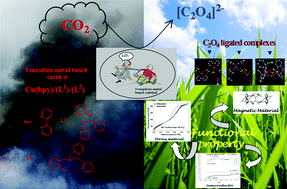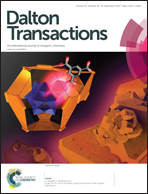Designed synthesis of CO2-promoted copper(ii) coordination polymers: synthesis, structural and spectroscopic characterization, and studies of versatile functional properties†
Abstract
A series of CO2-promoted Cu(II) coordination polymers in different coordination environments has been synthesized. The molecular description and properties of the four complexes have been investigated by CHN, MS, UV-VIS, IR, PXRD, TEM, SQUID, SC-XRD, NLDFT, and electrical property characterizations. Single crystal X-ray structure determination of [Cu(bpy)(C2O4)]n (1) and [Cu(2-AMP)2(C2O4)]n (2) depicts their polynuclearity [bpy = 2,2′-bipyridine, 2-AMP = 2-aminopyridine; 2-AMP is a cleaved ligand of starting ligand L1 = N-(phenyl(pyridin-2-ylamino)methyl)pyridin-2-amine]. Both complexes have distorted octahedral geometry. Starting from another tripodal ligand L2 [L2 = 2-((((2-(pyridin-2-yl)ethyl)(pyridin-2-yl)methyl)amino)methyl)phenol, L2′ (cleaved L2 ligand) = 2-(pyridin-2-yl)-N-((pyridin-2-yl)methyl)ethanamine], a mononuclear complex [Cu(L2)(Cl)] (3) has been obtained with a distorted square pyramidal geometry. Polynuclear complexes 1, 2, and 4 are CO2-mediated functional materials that have been produced in benzonitrile solvent medium. Interestingly, complex 4 of cleaved L2 ligand is a wonderful copper-based functional material with appreciable surface area. Powder XRD and TEM analysis of complex 4 supports its mesoporosity. Moreover, all four complexes can function as semiconductors over a wide temperature range.


 Please wait while we load your content...
Please wait while we load your content...